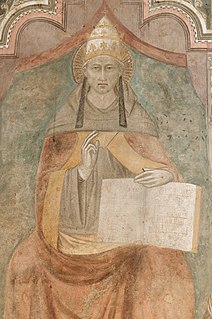
Pope Celestine V, born Pietro Angelerio, also known as Pietro da Morrone, Peter of Morrone, and Peter Celestine, was head of the Catholic Church and ruler of the Papal States for five months from 5 July to 13 December 1294, when he resigned. He was also a monk and hermit who founded the order of the Celestines as a branch of the Benedictine order.

L'Aquila is a city and comune in central Italy. It is the capital city of both the Abruzzo region and of the Province of L'Aquila. As of 2013, it has a population of 70,967 inhabitants. Laid out within medieval walls on a hill in the wide valley of the Aterno river, it is surrounded by the Apennine Mountains, with the Gran Sasso d'Italia to the north-east.

The Province of L'Aquila is the largest, most mountainous and least densely populated province of the Abruzzo region of Central Italy. It comprises about half the landmass of Abruzzo and occupies the western part of the region. It has borders with the provinces of Teramo to the north, Pescara and Chieti to the east, Isernia to the south and Frosinone, Rome and Rieti to the west. Its capital is the city of L'Aquila.

Santa Maria di Collemaggio is a large medieval church in L'Aquila, central Italy. It was the site of the original Papal Jubilee, a penitential observation devised by Pope Celestine V, who is buried there. The church, which therefore ranks as a basilica because of its importance in religious history, sits in isolation at the end of a long rectangular sward of grass at the southwest edge of the town.

Esanatoglia is a town and comune in the Marche, Italy.

Pacentro is a comune of 1,279 inhabitants of the province of L'Aquila in Abruzzo, Italy. It is a well-preserved historic medieval village located in central Italy, several kilometers from the City of Sulmona about 170 kilometres (110 mi) east of Rome. Pacentro has been nominated as one of the "Borghi più belli d'Italia".
Palena is a comune and town in the province of Chieti in the Abruzzo region of Italy.

Campo di Giove is a town and comune in the province of L'Aquila in the Abruzzo region of central Italy. Its territory is included in the Majella National Park. Located at the foot of the southwestern slope of the Majella, it is a holiday resort in summer and winter, thanks to the presence of a ski station. In English, its name means 'Campus Jovis'.
Sant'Onofrio is the Italian name of St. Onuphrius. This name may refer to:

The Montagne del Morrone are a mountain group in Abruzzo, central Italy, part of the Apennines. Overlooking the town of Sulmona, they are bounded by the Valle Peligna, the river Aterno and the Majella massif. They are included into the Majella National Park.

Tourism in Abruzzo has become one of the most prosperous sectors in the economy of Abruzzo, and in recent years has seen a remarkable growth attracting numerous tourists from Italy and Europe. According to statistics from the Italian institute of statistics (ISTAT), in 2007 arrivals totaled 1,371,155 Italians and 189,651 foreigners. A total of 7,374,646 arrivals were tourists, a figure that puts the region seventeenth among the Italian regions for numbers of tourists per year. According to market analysis and sector studies on tourism in the Abruzzo National Society TurisMonitor 2012, after an increase that was estimated at between 4 and 5% of international tourist arrivals in the Abruzzo region in 2012 was estimated to increase that international arrivals will be around 3/4% by the end of 2012 with staff working in tourism will increase settling at about 25,000 people. Always position first-arrivals from Germany. A moderate support to tourism is also given to the Abruzzo Airport with many low cost and charter flights connecting the entire region with the rest of Europe. Abruzzo tourism can basically be divided into three different types: mountain tourism hiking natural which includes numerous ski resorts, nature reserves and protected areas, beach tourism and coastal with the number of resort, hotel, camping and beaches, and finally the art-historical tourism religious and cultural concentrated mostly in mountain villages and historic towns such as l'Aquila, Vasto, Chieti, Teramo, Sulmona and many others.

The Abbey of the Holy Spirit at Morrone, known by various titles, is a former monastery some five kilometers outside of the town of Sulmona, at the base of Monte Morrone, in the Province of L'Aquila, region of Abruzzo, Italy.

The Hermitage of San Venanzio is the site the ancient hermitage of Saint Venantius of Camerino, located above a stream in a remote ravine within a few kilometers north of Raiano, Province of L'Aquila in the Abruzzo, Italy.

Eremo di Sant'Antonio is an hermitage located in Pescocostanzo, Province of L'Aquila.

Eremo di Sant'Angelo is an hermitage located in Lettomanoppello, Province of Pescara.

Eremo di San Germano is an hermitage located in Pacentro, Province of L'Aquila.

Eremo di Sant'Angelo is an hermitage located in Palombaro, Province of Chieti.

Eremo della Madonna dell'Altare is an hermitage located in Palena, Province of Chieti.

Eremo della Madonna di Coccia is an hermitage located in Campo di Giove, Province of L'Aquila.

Eremo di Sant'Onofrio is an hermitage located in Serramonacesca, Province of Pescara.
















